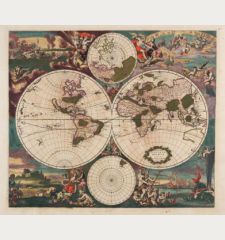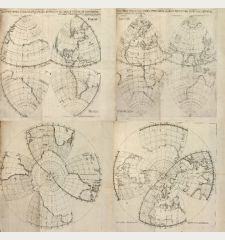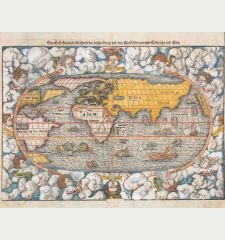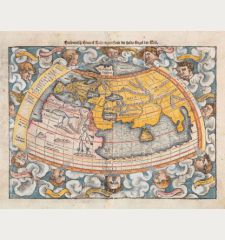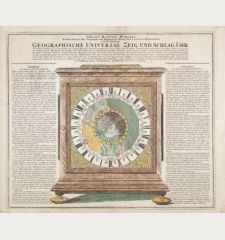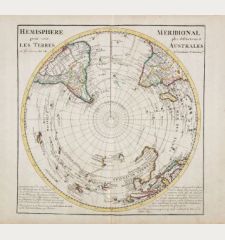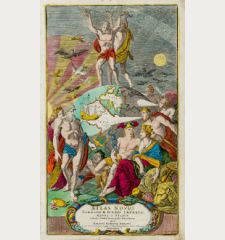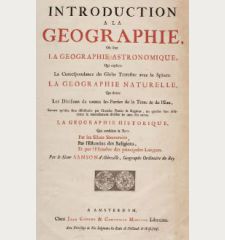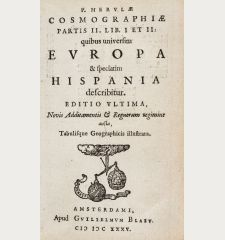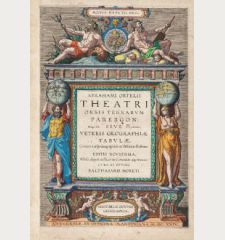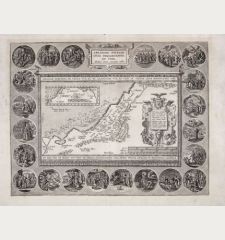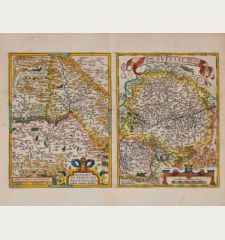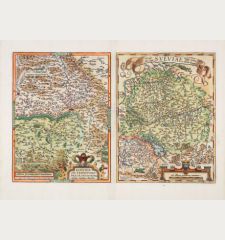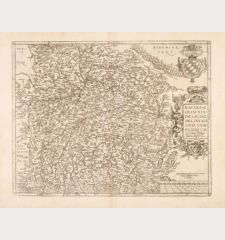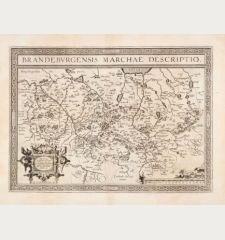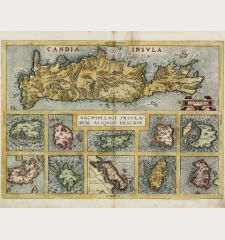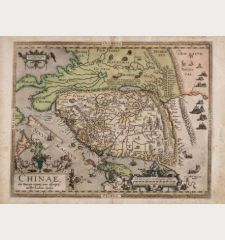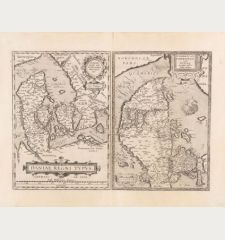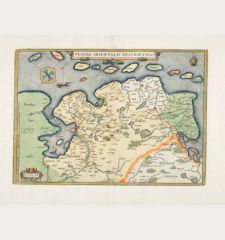Product successfully added to your shopping cart
There are 0 items in your cart. There is 1 item in your cart.
Typus Orbis Terrarum
Abraham Ortelius (*1527 - †1598)Reference 12681
Description
The first World Map in the First Regular Atlas - with Old Colours.
A fine old coloured and early example of one of the most famous world maps ever published. From the first modern atlas Theatrum Orbis Terrarum by Abraham Ortelius. "As the first world map occurring in the first regular atlas, this map is of fundamental importance in the history of cartography." (M. van den Broeke). The present example is from the first state of the first plate and the German first edition printed in 1572. A detailed description of the known world in German on the back side. Engraved by Frans Hogenberg.
The beautiful world map in an oval projection is surrounded by clouds, above the title in a scroll-work cartouche. At the bottom a quote by Cicero, in translation, For what human affairs can seem important to a man who keeps all eternity before his eyes and knows the vastness of the universe? Decorated with a galleon and two sea monsters.
R. Shirley describes the Ortelius Atlas with this world map in The Mapping of the World, No. 122:
For the first time, in 1570, all the elements of the modern atlas were brought to publication in Abraham Ortelius' Theatrum Orbis Terrarum. This substantial undertaking assembled fifty-three of the best available maps of the world by the most renowned and up-to-date geographers.
Unlike earlier compositions such as the Italian composite or 'Lafreri' atlases, each of Ortelius' maps was engraved specifically for his atlas according to uniform format. Through its launching, pre-eminence in map publishing was transferred from Italy to the Netherlands leading to over hundred years of Dutch supremancy in all facets of cartographical production.
Ortelius' map was copied widely, and derivatives were later used to illustrate works by Voisin, Broughton, Maffei, Belle-Forest, Petri, Hakluyt and others.
Geographically, the map is mainly based on Mercator's large map of the world, which was published a year earlier in 1569 and is only preserved in three copies. Ortelius also used the 1561 world map of Giacomo Gastaldi and Diego Gutierrez' portolan chart of the Atlantic.
Ortelius roughly adopted the American continent from Mercator. South America retains the unusual bulged southwest coast, which is no longer present in the later edition of 1589. The cartography of North America is largely speculative apart from the colonial centres in the Caribbean and central Mexico. The Atlantic coast extends too far east, the discoveries of Giovanni de Verrazzano and Jacques Cartier, such as the St Lawrence River are already depicted. The Chesapeake Bay is still undiscovered, the Mississippi River is not yet drawn despite its discovery in 1540, and the Great Lakes are also missing. The discoveries of the Spanish conquistador Francisco Vásquez de Coronado from 1540-42 in the western USA, such as the mouth of the Colorado River, are depicted. Quivira in the far northwest refers to the fabled gold country of Quivira, which Coronado sought as far west as Kansas in North America in 1541.
The southern tip of South America is separated from Tierra del Fuego by the Strait of Magellan, discovered in 1520, which is still part of the huge fictitious southern continent Terra Australis Nondum Cognita. The hypothetical southern continent was already supposed in ancient times. It was believed that all seas were surrounded by land, like the Mediterranean. It was not until Francis Drake's circumnavigation of the world in 1577-80 that he realised that the Strait of Magellan was not a channel between two continents and that south of Cape Horn there was only the open sea.
Several mythical islands are marked in the Atlantic, mostly based on questionable reports by little-known seafarers: Brasil, Frisland, Verde, S. Bradain and Drogeo. Legendary is the phantom island Sept Citiz in the middle of the Atlantic Ocean, better known as Antilia. It was said the island has been settled by a Christian community fleeing the Moors in the 8th century, leaving the Iberian peninsula by ship. The island of Saint Brendan in the northeast of South America, marked as Y. de S. Bo., was also considered a fact among scholars at the time this map was created. It was named after the Irish monk Saint Brendan, who supposedly undertook a legendary sea voyage in the 6th century and discovered this island.
Japan is still incorrectly shown as a large round island, Korea is not present. The Southeast Asian islands are already well depicted for the time. The legendary names Lucach, Beach (Land of Gold) and Maletur (Kingdom of the Malays) in the great southern continent Terrae Australis go back to Marco Polo.
For the first printing plate, Marcel van den Broecke distinguishes a total of 6 printing states:
1: original state 1570-1574.
2: from the Latin edition of 1574 onwards, the hatching around the Cicero quote in the lower cartouche has been altered.
3: from the Latin edition of 1575 onwards, bolt impressions appear in the lower left corner, to repair a crack in the copper plate.
4: from 1579 the crack is somewhat repaired and less visible. The clouds have been reworked.
5: from 1584 the date "1584" appears to the right of Hogenbergus sculpsit.
6: after 1584 the date is changed to "1585".
The present example was printed from the first state of the first copper plate as used between 1570 and 1574. It appeared in the first German edition of 1572, published by Egidius Coppens van Diest in Antwerp.
Details
| Cartographer | Abraham Ortelius |
| Title | Typus Orbis Terrarum |
| Publisher, Year | Gielis Coppens van Diest, Antwerp, 1570 [1572] |
| Plate Size | 33.8 x 49.8 cm (13.3 x 19.6 inches) |
| Sheet Size | 41.2 x 53.2 cm (16.2 x 20.9 inches) |
| Reference | Shirley, R. W.: The Mapping of the World, No. 122; Van den Broecke, M.: Ortelius Atlas Maps, No. 1.1 1572/1573G1; Van der Krogt, P.: Koeman's Atlantes Neerlandici, 0001:31A. |
Condition
Cartographer
Images to Download
If you like to download the image of this map with a resolution of 1200 pixels, please follow the link below.
You can use this image for publication on your personal or commercial websites for free if you set a link to this website. If you need photographs with a higher resolution, please contact us.

![Abraham Ortelius: Typus Orbis Terrarum Antique Maps, Ortelius, World Map, 1570 [1572]: Typus Orbis Terrarum](https://www.vintage-maps.com/3849-large_default/ortelius-world-map-1570-1572.jpg)
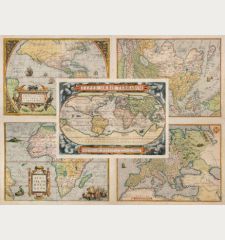
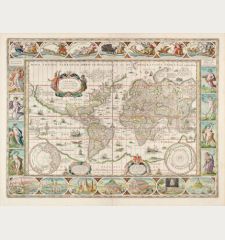
![Ch'onha Chido [Atlas of all under Heaven] Ch'onha Chido [Atlas of all under Heaven]](https://www.vintage-maps.com/3336-home_default/anonymous-korean-manuscript-atlas-chonha-chido-1820.jpg)
![Ch'onha Chido [Atlas of all under Heaven] Ch'onha Chido [Atlas of all under Heaven]](https://www.vintage-maps.com/4291-home_default/anonymous-korean-manuscript-atlas-chonha-chido-1800.jpg)
